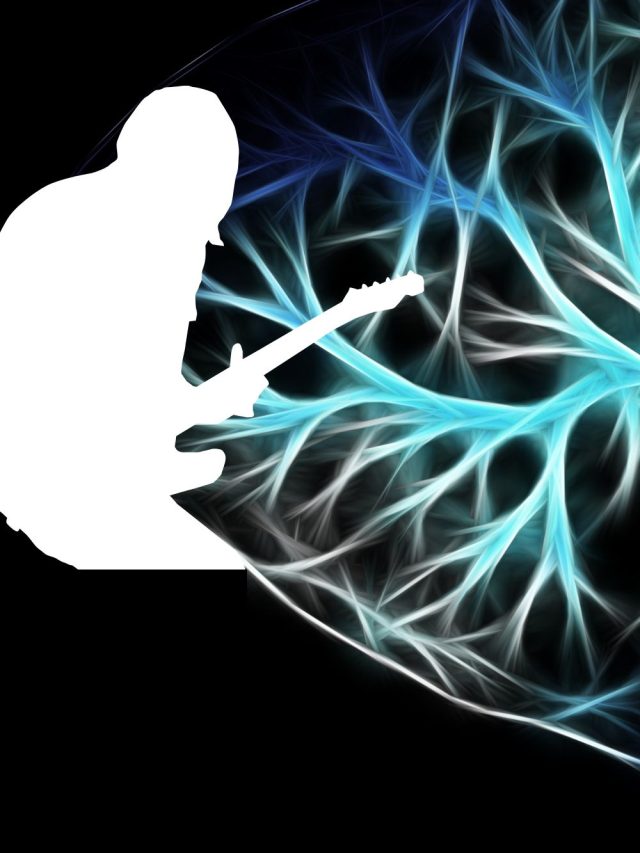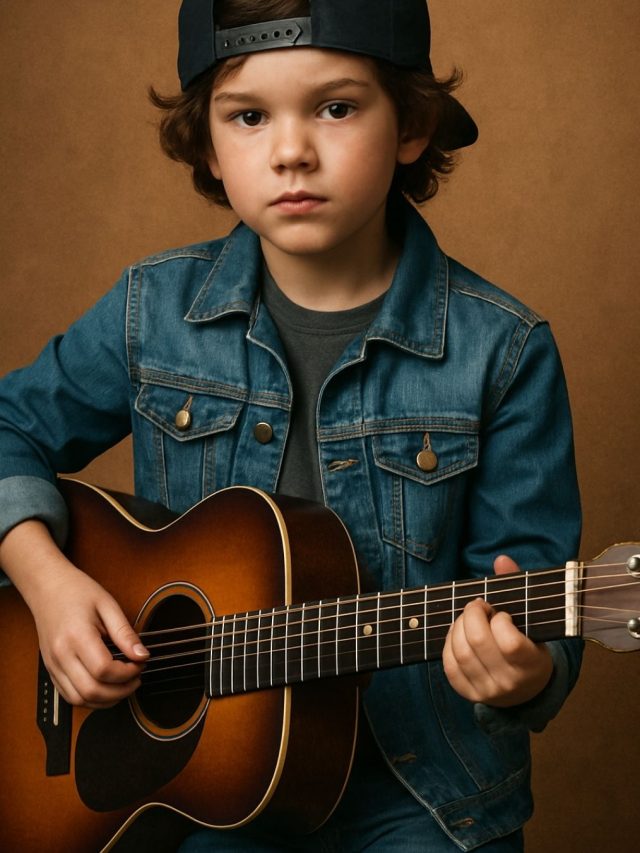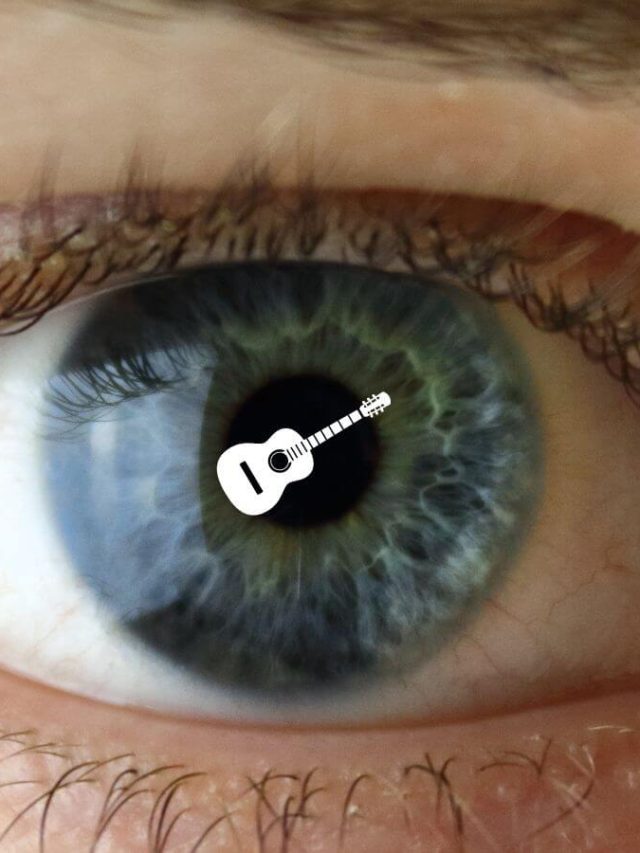Ever wondered how the brain learns and how you can use that information to improve your guitar skills? This is your foundational guide. We are going to look at a very specific set of tips on how to master the guitar in the realm of ‘Psychology & Neuroscience to learn the guitar better.’
Use all of the following tips on how to learn the guitar efficiently. I’ve focused on the guitar, but these can be used for virtually ALL stringed instruments.
Chapters
Why take this approach?
Why do we need to take this brain-based approach? Because many guitarists spend time practicing inefficiently and get utterly frustrated with no progress. So why not hack the brain’s learning mechanisms and implement them?
Here are a few examples of inefficiency and lack of progress:
- Practice 3-4 hours straight every day and make no progress
- Repeat a specific lick till you nail it, only to spend 3 weeks barely improving
- Mentally prescribe “Practice more” when one is stuck – without knowing what the precise problem is
- Practice one category over and over again till default improvisation skills become restrained and limited to that category
- Spend 2 years learning chord transitions and still not execute them well
- Practice one thing so much that other domains get overlooked and then get upset by how much you worked without feeling better about your skill
- Practice scales up and down. Learn many songs without ever attempting to create new sequences. Practice scales, chords, modes, and techniques without putting them in larger contexts and networks of musical ideas
- Practice a technique in isolation only to realize that you practice well but fail to implement it in music
All learning is neuroplasticity. Neuroplasticity is the brain’s ability to rewire itself and convert poorly formed circuits into strong, reliable neural patterns. It is a process where plasticity occurs while learning and reduces when something is fully learned. When we have neuroplasticity, the learning is confirmed in the brain and is ready to execute – so all guitar movements are executable when neuroplasticity has occurred and stopped, and all guitar movements are imperfect when neuroplasticity is still occurring.
Plasticity does 2 things:
- make your playing automatic (improve muscle memory)
- improve pattern recognition (detecting sounds, remembering playing shapes, etc.)
All of the techniques below will improve plasticity in the most efficient way. The key areas where the brain needs neuroplasticity for better guitar playing is: the motor and sensory motor cortex (to govern finger movements), the prefrontal cortex (to make playing decisions), the temporal and occipital lobe (for sound and visual processing), and the hippocampus (for learning new things that later become stable neural connections). No matter how you learn, neuroplasticity will occur – it’s automatic. But, the goal here is to speed it up.
I’ll first explain the guitar learning strategies and then speak about how they would help you in your guitar training. I’ve often asked my students to use these over traditional exercises because training your brain to play the guitar is better than just training your fingers.
1. The transfer effect – let one guitar lick help the other
The brain has an inherent property called the “transfer effect” via “neural reuse”. The transfer effect occurs when doing activity ‘A’ helps improve activity ‘B’. Both tend to share a neural pattern – so neural reuse. For example. Learning how to ride a bicycle helps to learn a motorcycle. The skills needed to learn a bicycle are transferable to motorcycle learning. It is very useful to bank on the transfer effect. Let us say that you are doing a scale, and it looks like this:
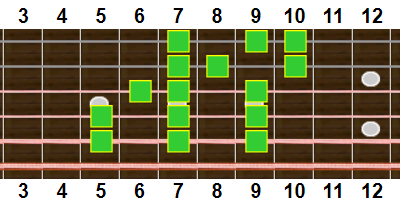
Then you want to compose a riff in the following pattern.

Any pattern you play within the scale in Fig 1 can indirectly help you play Fig 2. Repeat 3 or 4 times, and you will have acquired the muscle memory for doing those patterns instead of playing the scale over and over again. The transfer
While transfer effects occur automatically, what you need to do is accelerate them by practicing transferrable skills. Transfer occurs on multiple dimensions.
- Reuse: When the exact finger pattern is used again (same movement, different frets). So learn as many as you can without being too redundant.
- Near transfer: When similar finger movements improve (consecutive string patterns improve similar string-skipping patterns, pull-offs between 3 frets to pull-offs between 4 frets with a note in between). So learn many ideas without going too deep into each and move on to something else.
- Far transfer: When skills generalize beyond context and improve something else (typing speed or tutting skills improve because you start shredding). When it happens, you are likely to have holistic musical and cognitive skills[1] that improve just via the guitar. Most commonly, better sound perception, better finger dexterity, better planning, etc. Similarly, other cognitive activities you do, like learning the Rubik’s cube, coding, new languages, painting, etc., will transfer to the guitar. So if you can afford it, try learning another unrelated activity while you learn the guitar. Both will help each other.
- Bilateral transfer:[2]What you practice with your left hand improves right-hand dexterity. This is one of the most well-demonstrated biological facts. This means if you learn finger picking with all 4 or 5 fingers, you are effectively improving your fretting control. This also means you can alternate between left and right-hand movement practice and automatically train the opposite hand.
2. Chunking – group notes together
Chunking is a process where you represent many small bits of information as single groups and concepts. For example, you can
You can chunk a melody, a finger movement, a bar, an entire section, etc. Ideally, your chunk is a meaningful group of finger movements/positions tied to a melody that can become automatic. The more you practice your chunk, the more automatic it becomes.

The highlighted section is a chunk that is re-used. Whether you learn that finger grouping in the major chord context or the minor chord. Training just that and then adding the other notes can help to learn. Chunks are essentially meaningful breaking-down of complex parts.
Even a rhythm can be broken down as chunks – Down Down Up Mute Down Up Up Pause can be a Down Down Up Mute + Down Up Up Pause.
3. Creative Visualizations & Sensory Abstractions:
Visualizations
Use your mind’s eye (imagination) to play your guitar part at the speed that you want to achieve. With extremely fine details, visualize yourself playing the part. Try to imagine yourself playing that part perfectly. While visualizing, let your imagination include details like the position of your hand, your guitar’s point of view, the point where you are looking, etc. This will help in the following ways:
- Priming your brain (specifically your motor cortex) to be ready for the guitar piece before you actually execute it.
- It will minimize the errors because you have imagined the correct way to execute it.
- The physical time required for the brain to send a signal to your fingers will be reduced as the brain has established a rough neural link for that particular guitar bit.
It will also help if you can visualize very slow and very fast versions of the same piece with as much detail as you can imagine (if you can mentally hear the piece, this will be even more useful).
We talked about visualizing a lick which takes care of the sensory part of concept forming. When you learn a lick, the visualization grounds your learning in an abstract concept in your brain. Your actual playing gets tethered to that abstract representation in your brain. This makes learning easier. However, the story doesn’t end here. Read this article[3] to know more about the essence of abstraction in the brain.
You can form abstract concepts via other sensory channels too. For example, humming a guitar lick will follow a different method of abstraction: Guitar lick -> vocalizing -> abstract concept based on voice melody -> feedback to your finger movements with the guitar melody -> concept grounding in the brain. So ultimately, singing a guitar lick will help to learn the physical guitar lick.
One powerful sensory abstraction is to use shapes and map them to a lick. These can be literal shapes or abstractions such as mentally visualizing a line moving up, down, staggered, etc. You can add white spaces in this line and circular loops too. You can move in any direction – up, down, forward, backward, rotate.
These visual/spatial abstractions ground and anchor your learning in an efficient way – it’s easier to remember and use an abstraction than process the entire musical sequence. Imagine the abstraction is a URL or identifier for your music that loosely captures the properties of your music. Another way to think of abstraction is that they are “compressed” versions of your learning. Unlike computers, brains do a better job at searching a compressed space.
Vocalizations
Rhythm can be abstracted with words. If you can’t get the rhythm right, you can use nonsense words & sentences like Bo No
Richard Hoffman, William Pelto, and John W. White started a similar system called Takadimi[5] in 1996 to teach rhythm. That’s based on the Hungarian Kodály method, which shares its roots with the 5000-year-old Indian musical tradition of Konokol. In Konokol, each subdivision of a bar (2 notes to 10 notes as groups) has a dedicated phrase like Tha Ka for 2 notes and Tha Ka Dhi Mi Tha Ka for 6 notes. Each syllable corresponds with a note. So each phrase corresponds with the timing of all the notes.
Rooted in these traditions, the BoNo is a slightly more simplified version:
- 1 single notes Bo__ No__ Bo__No__
- 2 notes BoNo BoNo
- 3 notes BoNoBo BoNoBo
- 4 notes BoNoBoNo BoNoBoNo.
If you’d like, you can use other syllables which were more suited to your native tongue, so it’s even easier.
While paying attention to your picking, you may lose your focus and not remember if you did all 16 notes or fail to realize if you did a quadruplet instead of a triplet. If you can’t notice the difference in the sound of 3 quick notes or 4 quick notes, mapping them to words will help – because it’s easier to identify and process words. Here, you can use non-sense words, and you just have to see if your hand synchronizes with the words. When you speed up, it is easier to sound out the words and then use those words as a clutch for your picking.
Layering
Another way to abstract a guitar lick for learning is to represent it in layers. Think of the pedal pointing licks in neoclassical playing. The intro notes are one layer. The tail ends, and ascending/descending notes are another layer. It takes practice to break down a lick and develop a mental template of layers.
Ultimately, you are going to be using all of these sensory abstractions to ground your actual guitar lick in a concept that is heavily reinforced. This reinforcement makes learning the guitar far easier than you can imagine.
In a broader sense, visualization is just a word for a ‘sensory abstraction.’
4. Pre-sleep revision
Do the visualizations before you sleep. These visualizations prime the brain to process the attached learning (attached to the visualization) by giving it an “importance” tag. The brain does most of its learning during the Rapid Eye Movement part of sleep (R.E.M. cycle is that time during sleep when you get most of your dreams and your eyes are rapidly moving with lids shut). There is only so much you can do in a day by physical training. Because learning happens overnight, sleep is your best teacher. Let the brain do its job, and you’ll be surprised to see how good it is. Warning: Do not overdo playing a part. You’ll be fatigued, and your brain will not be able to optimize its resources for learning overnight.
Suppose, instead of visualizations, you want to play a real guitar. Do that for a few minutes. But don’t overdo it because your biological systems will get aroused, and that will prevent sleep.
You can also listen to low-volume guitar songs and fall asleep to them. This will help you sleep and still give guitar-related information an “importance” tag.
5. The 2 extremes strategy: Local and global features
Regardless of how well you play your part, try to play it extremely slowly and extremely fast, faster than you need to. You’ll learn what your playing sounds like and what all went wrong at 2 levels: Global and local. It will also set a higher standard for your brain to achieve, and now it will work towards strengthening the neural connections to be that fast (many times actually succeeding).
Since music is literally a function of sounds laid out across time, how your attention processes that time is very important. When you play slow, fewer notes but more minute details enter your attention. However, when you play fast, more notes and more global structures enter your attention. In the first case, you process local features. In the second case, you process global features.
Local features are: How you pick/pluck, how you land on a note, how much you shift your hand, how you ready your mind to shift to the next note, etc. It’s easier to process the dynamics and note accuracy if you focus on local features by slowing down.
Global features are: The entire contour of the sound, the whole melody, the vague positioning of your hand, etc. It’s easier to process the start and end of a melody if you focus on global features via speeding up.
Playing slow is like hyper-zooming into a photo. Playing fast is like zooming out and looking at the big picture. Both give you details across time (in music) instead of space (in photos). When attention locks into details at both local and global levels, your brain starts building the necessary biological resources to learn both.
6. Variation in learning any guitar piece
One of the strongest predictors of any physical learning is variation. Simply put, the more variety you practice the more adaptable and flexible your finger movements will be. But that is only superficial variation. There is microvariation that you need to practice.
Say you have a lick to practice starting on the 9th fret. Practice it on the 6th, the 15th, 2nd, 12th, etc. Changing the fret will change the micro-aspects of playing – the exact placing of the finger, change in pressure, etc. when you change the fret, the brain factors in these micro-variations and help learn the ‘approximate’ finger movement which is far superior. You’ll see this happen in sweep picking. Many can only do 1 or 2 sweep-picking shapes near the 12th fret because that’s all they have practice. Variation in which string you learn a lick is extremely useful too. Because each string is just slightly physically different, there is a muscle-related adjustment on the fretting and picking hand. Practicing a nice shred lick on the B and E string is great but practicing it on the low E and A is even better. This variation is key to flexibility in learning.
Key takeaway: Variation allows your brain to take wider inputs from your fingers and then zero in on the best average way to execute a lick in the brain. Those neurons which learn via variation then move your fingers. Higher variety increases neuroplasticity by recruiting new neurons and forming new stable connections. Variation in learning promotes precision and speeds up learning. However counter-intuitive this sounds, variation in learning improves and speeds up what we call ‘muscle memory,’ which is essentially newly developed neural connections.
Here is a list of things you can vary for a particular type of lick/chord sequence to learn it better.
- Starting and ending notes
- Starting fret (across the whole fretboard)
- Starting string (all strings)
- Picking strength (light to heavy)
- Forced accents (
emphasizing a vibrato or a heavy picking on a certain note) - Mixing up legato or
hammer-ons if they suit the lick - Your body posture while playing (standing, sitting, cross-legged, sleeping, while doing a handstand, while doing the hanky panky, etc.) Changing the posture adds variation in global muscle movements, which creates the need to learn new ‘adjustments.’ These further reinforce the core aspect of what you need to play.
7. Interleaving – practicing a variety of chops together
Interleaving is the process of mixing things up in your hammer-ons routine. Practice similar licks one after the other in a mixed fashion. Say you have 3 similar licks – A, B, & C. Spend a few minutes on A, then B, then C. Take a small break. Come back to A, then B, then C. Repeat. Then you can change the order. Improve your guitar learning by mixing the order of licks/riffs/chunks. Interleaving is unequivocally better than spending too much time on a single chop. You can read more about this technique here[6].
Interleaving guidelines:
- Practice similar licks in one learning session: This creates flexibility and deeper understanding of each lick. Keep something common in all licks – chord sequence, technique, or style.
- Practice in blocks of similar licks: When you want to move between dramatically different licks, create a new practice session and then play a small variety within that category.
- Shuffle your playing order, so you don’t train your brain to only play a certain progression: This is very important for improvisation because then you can quickly start any lick you want. Otherwise, you’ll get conditioned to properly play a lick only after you play a previous lick.
8. Building muscle memory
So making your finger movement and your picking motion minimalistic will be a starting point. Then you need to speed up your brain-to-finger connections. Neurons signal each other at about 300+ miles per second. Which really isn’t very fast. So you would want to make certain motions ‘automatic’. Use the transfer effect, chunk, and visualize. Add variations in licks and explore physical variations on the guitar in your core learning process. They help you automate the required movements. Do this for a few days, and you’ll be faster, better, stronger, flexible, and cleaner.
In case you are unable to do any of these properly, don’t worry. It takes some time, and then they become your most powerful tools for learning anything. Speed increases when the least amount of energy is needed to accomplish your task, and this happens when your playing becomes more automatic.
Muscle memory is practically unlimited. Repetitions, after a while, stop being as effective as you might want them to be. A few hours to a few days’ break in playing is very useful. This is because the brain learns a lot and consolidates learning while you are sleeping or idle. Let the brain do its job. More learning is happening when you are not practicing the guitar (as long as you do practice routinely).
One interesting related feature of the brain is “repetition priming[7].” When practicing some fine motor task – guitar playing – a few repetitions of a lick/sequence can start a self-sustained process of memory consolidation. That means just a few reps of a lick can automatically signal your brain to keep learning even when you stop the repetitions. But you have to repeat the sequences a few times to kickstart this. The more you hear yourself play, the more you fret or pick, the more you imagine how you sound like, the better it is because you are repeatedly priming your brain to process it… but only to a point. Extra repetitions of crude performance (not perfect performance, see pro-hack 2 below) can add no extra value to learning because the learning process goes on automatically after you pause for a while. This becomes more profound after a good sleep because that is when your brain really pins down that learning and makes it robust. Overpracticing an imperfect lick can not only hamper repetition priming but can keep generating new signals, which can confuse the learning consolidation process. When neuroplasticity begins via repetition, it has to stabilize. But, the correct version of the lick has to stabilize, so it’s best not to overpractice wrong hand movements.
9. Feedback in playing the guitar
Your relationship with the guitar
In all of these techniques, one thing needs to be highlighted over and above everything. That is – feedback from the guitar to you and you to the guitar. You need to be mindful and attentive to details – sounds, physical movements, your feelings, your surroundings, etc. Use all those details to learn, adjust your playing, correct mistakes, etc. Without feedback, you won’t know what you did. Your eyes, ears, skin, and body need to take notice of as many details as possible so you can use those details to improve. Feedback also allows you to do another important thing: Verify if you’ve learned something. Feedback is useful in all sorts of learning – your eyes, ears, mind, etc.,
Getting feedback
Jamming with a variety of people is an excellent way to utilize feedback mechanisms. Many guitarists love to jam but limiting jam sessions to a specific genre, or a set of people can compromise the added potential of learning. Jam sessions can also create a perspective change – because you are in a different context; because you are subjected to some collective musical expectation; because you might have a different guitar; because you might have a different tone; because others are watching. All of these aspects function as “cues” which separate you from your practice routine, and this separation makes your brain’s approach different. Essentially, this gives you the value of “real-world experience” as opposed to “theoretical knowledge.” If you don’t know how to start jamming, I recommend using the blues as a stepping stone.
It is often more useful to observe others play and externalize your attention by focusing on the learning outcome. What I mean by that is – focus on the global aspect of how your guitar should sound. When you externalize attention, you would focus on the sound and feel instead of wondering if your fingers landed on the frets correctly.
Recording yourself (audio & video) allows you to process feedback and create a psychological distance between you and your playing. The psychological distance can change your perspective and reduce emotional involvement. So distance can bring out errors and change your initial impressions. Recording yourself forces the brain to change the details it processes. That is the most important feedback for a musician.
I’ve written a short how-to on how to get feedback on your guitar playing which you can read if that’s your bigger concern. I’ve summarized the points below.
Here’s how to get feedback:
- Record yourself
- Perform in front of someone
- Video yourself
- Ask people for comments (not friends, randos)
Here’s the type of feedback you need to work on:
- How your guitar sits with the background music
- How your body moves with the guitar
- How your face responds to your playing (it shows confidence, nervousness, etc.). Your feelings affect your dynamics.
- Technical feedback
- Overall impressions
- How others build and respond to what you are playing (are they restrictive? can they improvise? can they shine?)
When asking someone else for feedback: Remind them to give you F.A.S.T. feedback[8] – you want to work on something that you can do in the future (feedforward), you want to do something that can be implemented in your music quickly (actionable), you want to work on one thing well instead of all things (succinct), and you want the feedback to be relevant in a few days (timely).
If you can’t get feedback from others, take a break and analyze your music from a distance. When you are emotionally detached and some time has passed since the last time you played something. This is when you create your own feedback and work on that. Avoid self-judgments – never target the person while giving feedback, target the actions. Focus on your exact behavior (techniques, skills, thought process, playing habits, etc.).
Multiple levels of processing feedback
Finally, we are coming to the most global aspect of playing the guitar – levels of processing or construal level[9].
It’s closely tied with feedback, but it is different from what we’ve discussed so far. Construal level or the level of processing is how deeply you are processing a musical sequence.
- Are you focusing on the essence, which is the chord structure or a bassline?
- Are you focusing on the super attention-seeking notes within a melody?
- Are you focusing on the rhythm? Are you focusing on different aspects of music in isolation?
- Are you focusing on interactions between different sounds?
- Are you focusing on the global “feel” of the song?
- Are you imagining the technical visualization of a riff?
Answers to these questions define your “level of processing” or the “construal level.” Simply put, it is the level of detail at which you process your own music or someone else’s music. Low details/High construal level allows you to easily focus on the essence/feel and relate music to other similar songs – something very useful in broadening your perspective and learning holistically. High details/Low construal level helps you focus on the finer detail and appreciate the nuances as well as the uniqueness of music – something great to refine your skill and musical sensitivity.
A high construal (low details, more feel) gives you psychological distance – it separates you from the musical details. This is important to understand how others perceive your music.
A low construal (high details, more technique) removes psychological distance – it helps you connect with the building blocks of your music. This is important to understand how well you are performing and composing.
Mix the construal level approach to music (the construal level) with feedback, and you’ll be able to take your guitar playing to the next level. It’ll create an abundance of opportunities to increase the depth and breadth of your learning and creativity.
10. Give every new learning a name and make it a concept
This one is quite easy. All you have to do is to give what you learn a name, so it becomes a concept in itself. When you don’t give a musical structure or technique a name, you are in “hypo-cognition,” which means the brain doesn’t have enough cognitive components to process that musical structure/technique. Because of this, it becomes harder to utilize it in music and also harder to identify it when others use it. Instead, you should enter a normal cognitive state and do the following to acquire new concepts.[10]
- Give lots of examples of things that belong to a category and things that do not belong to it. E.g., learn examples of a technique or chord intervals and compare and contrast with other techniques and chords.
- Identify co-occurring features between 2 related or unrelated concepts. E.g., Notice how 2 techniques like strumming and sweep picking have similarities while doing arpeggios.
- Identify exceptions or improperly classified concepts. E.g., Understand typical compositions in a genre but also understand how other genres use those concepts.
- Refer to examples as examples and concepts as concepts, instead of interchanging the two in daily conversation. E.g., Look at how tapping like Van Halen is an example of a concept called tapping and clearly see how not all tapping sounds like Van Halen.
- Assign visual models, sounds, movements, touch, taste, smell, and context when possible. E.g., use all sorts of sensory words to describe your music and understanding. Pay attention to the song in which you heard something, the player who played something, and details on how a musician looked, moved, and created sounds.
- Label concepts with words. E.g., Give a name or find a name for each technique, sequence, and process.
- Have variety in examples and properties. E.g., learn how different musicians approach a particular idea.
- Differentiate between similar concepts. E.g., Understand there are many types of chords that sound similar but have key differences – like the 7th chords[11].
- Draw similarities between 2 concepts to see if they converge or don’t. E.g., Observe how economy picking and alternate picking look the same when you use an odd or even number of notes per string.
- Represent an associative network of concepts. E.g., Cluster similar ideas together.
- Process concepts at their smallest feature levels and highest abstract levels (construal levels). E.g., Pay attention to the overall feel – aggressive, dynamic, playful, fluid, choppy, etc. – and minutest details – technique, single note harmonies, precision of bends, harmonics, etc. – of composing, practicing, and jamming.
Try to find the standardized name but your own words and labels are enough too. You can call a chord sequence “2-5-1,” or you can call it the Jazz cliche. As long as you have cognitive components to represent the music with words, visuals, or labels, you are acquiring conceptual understanding.
11. The forgetting and decay curve
When you learn something and succeed at playing it correctly, you may feel great about your skill. But there is another issue – it starts deteriorating if it’s not played again and rehearsed. This is the forgetting curve – memory starts to decay over time because newly formed “plastic” neural connections begin to deteriorate. But there is a way to infinitely delay this decay by strengthening neuroplasticity.
The trick is to use what psychologists call “Spaced Repetition” – if you learn something right now, practice it again in 20 minutes. Then come back and play it 2 hours later. Then 5 hours later. Then the next day. Effectively, you are increasing the time between rehearsing a lick to reinforce it. This slows and flattens the decay curve.
Skill performance curves
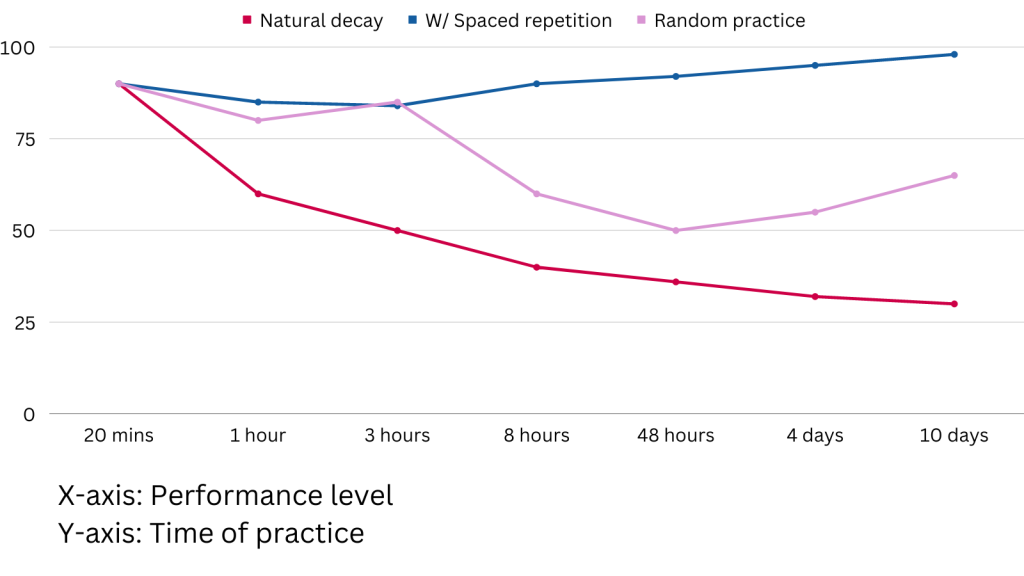
Natural decay is when you learn something and stop rehearsing it later.
Spaced repetition is when you rehearse your skill with increasing gaps in between.
Random practice is when you occasionally practice with unexpectedly large gaps in between or practice for 2 days intensely and then return to it in 10 days.
You can extend this curve till the end of time. At some point, you’ll only need a little bit of practice to prevent memory decay and reinforce your learning.
Supporting learning tricks
There is so much more to the science of learning that it’s hard to contain it here. I’ve listed 4 quick guitar learning hacks below, but I’ve gone in-depth in this linked article. Check that out if you’d like!
Pro-hack 1: Use lower frequency notes to draw an outline of the rhythm structure and main notes – Humans process time better at lower frequencies[12]. Or, you know, buy a bass or find a bassist. This is also one of the reasons why the bass feels groovier.
Pro-hack 2: Overlearn your target skill level – Once you nail something, do a few extra repetitions to hammer in your chops to prevent a drop in skill over time. Overlearning[13] (practicing after successfully learning something) will also reduce interference from other learning and activities that can weaken your performance gains.
Pro-hack 3: Use a blindfold to improve muscle memory and pitch memory – When visual feedback is cut[14], brain activity in touch and sound processing increases due to neural plasticity.
Pro-hack 4: Take a nap right after an intense practice session – Daytime napping[15] can improve memory consolidation of motor skills. So if you are struggling to see progress during a practice session, sleep will speed it up before your next session.
Summary of the best guitar learning tips:
- Use the transfer effect to let one chop help the other chop automatically.
- Chunk notes in meaningful groups and
treat them as one. - Revise guitar notes mentally before sleep.
- Learn to visualize & hear notes with your mind’s eye with as much detail as possible.
- Learn to play the 2 extremes: Really slow, and really fast.
- Add variations in playing and add variations in how you practice guitar licks.
- Use the interleaving practice method – practice multiple chops in pseudo-parallel (one after the other & then repeat) in small sessions.
- Bonus: Pay attention to all sensory feedback – touch, sound, sight, posture, movement, etc. and use to improve.
- Bonus: Use the 1% improvement rule. Just aim to improve a little at a time. Don’t expect to be Michael Angelo Batio or Vinnie Moore in a week. Over the year(s), you’ll get there. Consistency with short sessions is important.
- Don’t neglect the global aspect of playing which is the sound and feel. Know what the expected outcome of playing is and work towards that.
- The majority of learning happens when you are sleeping. Maintain a healthy sleep routine to witness significant growth. Plain idle time is also useful for learning. You don’t ‘have to practice’ all the time 24/7.
- Form guitar lick concepts in your brain via multiple sensory abstractions like humming a melody, shadow movements, sequences of ups, downs, loops, steps, representations as shapes, etc. to learn better. Use nonsense words to map out rhythmic structures. Define guitar licks in mental templates – as a mental model[16] of your guitar lick.
- Jam with other guitar players as well as other musicians.
- Record yourself – close-up videos, audio, bad-angle video, blurry video, single-take recording, 100-take recording, etc.
- Process and practice music at different levels of details – practice bringing out the feel in itself and practice bringing out unique qualities. Both are important.
- Name your compositions, techniques, sequences, ideas, etc. Make them tangible concepts.
- Use spaced repetition – rehearsing with increasing gaps in between 2 sessions to prevent natural decay of skill over time.
A small note on how to stay motivated to play the guitar: Read it here.
I’ve managed to successfully test these techniques. Luckily (in retrospect), I am a self-taught musician, so I got to explore many things; and as an applied psychologist, I applied these cognitive strategies and modified them for learning how to play the guitar. Been playing since the age of 10 and taught guitar for 8 years. Even conducted research on music learning and perception.
Have fun learning, and do spread these insights!:)
References
[2]: https://pubmed.ncbi.nlm.nih.gov/11723973/
[3]: https://cognitiontoday.com/the-kiki-bouba-effect-research-overview-explanation/
[4]: https://journals.plos.org/plosone/article?id=10.1371/journal.pone.0080402
[5]: https://musescore.org/sites/musescore.org/files/2022-01/TakadimiArticle.pdf
[6]: https://cognitiontoday.com/how-to-study-5-scientific-study-techniques/#2_Interleaving_An_effective_but_counterintuitive_technique
[7]: https://www.researchgate.net/publication/11445698_From_primed_to_learn_The_saturation_of_repetition_priming_and_the_induction_of_long-term_memory
[8]: https://www.sciencedirect.com/science/article/pii/S2352250X22001269
[9]: https://cognitiontoday.com/creative-cognition-construal-level-theory-psychological-distance/
[10]: https://cognitiontoday.com/basic-concepts-about-concept-formation-theory/
[11]: https://www.learnguitarmalta.com/7th-guitar-chords-in-theory-and-in-practice/
[12]: https://www.academia.edu/19724242/Superior_time_perception_for_lower_musical_pitch_explains_why_bass-ranged_instruments_lay_down_musical_rhythms
[13]: https://www.nature.com/articles/nn.4490
[14]: https://pubmed.ncbi.nlm.nih.gov/15050709/
[15]: https://pubmed.ncbi.nlm.nih.gov/17694051/
[16]: https://cognitiontoday.com/mental-models-a-way-to-unlock-genius/





